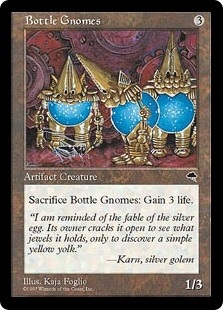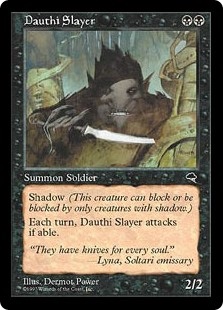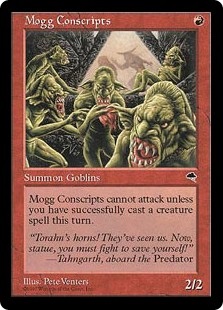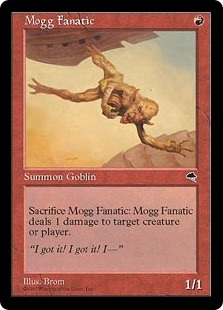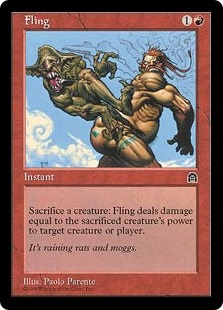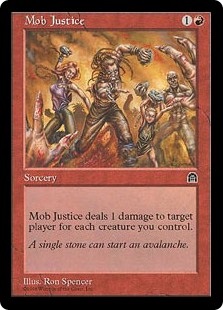Last time we looked back at the first ever block designed for Limited play, the Mirage Block. This week we look at the first of Magic's blocks actually designed as a block: The Rath Cycle.
As a story, Tempest was originally conceived by Mark Rosewater and Michael Ryan with a cool series of storyboards that translated card-for-card into the card names and images that made it into the set. Tempest was also Maro's first ever lead design of a Magic expansion.
Even as Magic reached this second era of design (and obvious color pie breaks became fewer), there are still a remarkable number of commons that became Magic tournament cards and Pauper staples. Take a look at these 20 from Tempest block.
Tempest
Bottle Gnomes: An early tournament card that was surprisingly relevant in a world of Sligh decks, Bottle Gnomes was one of the first creature cards that had a free sacrifice ability.
This card backdoored into Pauper legality thanks to a Tempest Remastered downshift and for a time it was considered an effective stop gap against Burn decks, especially Keldon Marauders.
Capsize: Buyback is a broken mechanic that leads to repetitive game play, or at least that's what Magic R & D would like us to believe. One of the worst Buyback offenders was Capsize since it was missing the word "Nonland". What this meant was that a six-mana advantage could lead to freezing the opponent's mana development forever. Eventually this would snowball into the opponent having no permanents at all. It's like Tradewind Rider with no creatures required.
Capsize still plays backup control finisher in mana Pauper Tron decks today. It's greatest drawback is the MTGO clock since it can take a lot of ticks to repeat the cycle of returning permanents when you still need to find an actual way to finish out the game.
Dauthi Horror and Dauthi Slayer: Shadow is an interesting mechanic. Originally seen as a form of "super-Flying", it cut both ways. But since the best Shadow creatures skewed aggressive, it mostly played as a kind of free evasion for cheap attackers like these two. Shadow's best tournament staples were Soltari Monk and Soltari Priest.
Mono-Black Aggro is one of those hypothetical Pauper decks that never quite seems to get there. But when we try to build it, these two have the 2-drop slot locked in.
Diabolic Edict: A Legacy staple, Diabolic Edict was the first of its kind as non-targeted spot removal. Even the Magic term "Edict", referring to forced sacrifice effects like the one on Liliana of the Veil, gets its moniker from the OG Tempest Diabolic Edict.
Chainer's Edict, its Torment spiritual descendant, sees the most play of the bunch. But Diabolic Edict still has plenty of Pauper utility, as do Geth's Verdict, Celestial Flare, and Innocent Blood.
Evincar's Justice: Another egregious buyback spell, Evincar's Justice doubles as a sweeper and a finisher, provided you have enough mana security to keep the fun times rolling.
Speaking of fun times, Evincar's Justice is the finisher in one of the most miserable Pauper decks ever diabolically assembled, the "Caligula" deck, or death by a thousand paper cuts. Commonly paired with Pristine Talisman, there is nothing quite like slow whittling your opponent's life total, even if it means finally winning the game on turn two7.
Lotus Petal: Another Legacy staple buried at common! That's two so far for Tempest. Initially mocked as a worthless and anemic variation of Black Lotus, just as Lion's Eye Diamond and Lotus Vale had been, the Lotus Petal still does work in decks where establishing spell count for Storm or cheating out a Turn-2 monster matters.
While Pauper legal, it's hard to fully abuse Lotus Petal since Storm is the one Pauper strategy that was been all but banned out of existence. Once in awhile Mono-Green Infect reemerges in Pauper, a deck that can Turn-2 kill with Lotus Petal's help, if the right draw is in the cards.
Mogg Conscripts: While not Red's first ever 2/2 for ![]() , Mogg Conscripts was a heck of a lot easier to build around than Ice Age's Orcish Conscripts, a card which itself got a power upgrade in Stronghold's Mogg Flunkies.
, Mogg Conscripts was a heck of a lot easier to build around than Ice Age's Orcish Conscripts, a card which itself got a power upgrade in Stronghold's Mogg Flunkies.
Goblins has long been an established Pauper deck such that casting a creature spell every turn is hardly a drawback to overcome. Mogg Conscripts also plays spear carrier in the Pauper version of Red Deck Wins, a deck that tries to pile power and avoid X/1s as much as possible.
Mogg Fanatic: In its original rules interpretation, Mogg Fanatic was one of the most powerful 1-drops ever printed. Thanks to damage using the stack, you could attack or block with Mogg Fanatic, assign its one point of combat damage and also sacrifice its body to ping elsewhere. Once Magic 2010 took away damage using the stack, Mogg Fanatic got a significant nerfing.
Having direct damage on a stick is still a powerful ability in Pauper, evidenced by cards like Icatian Javelineers being marginally relevant. It's hard to say which is a better Goblin these days between Mogg Fanatic or its spiritual descendant, Ixalan favorite Fanatical Firebrand.
Mogg Raider: A surprising relevant ability on a 1-drop 1/1 is being able to sacrifice any creature at will. Not only does this let you dodge life-gaining removal spells like Tendrils of Corruption, but it lets you stack damage onto an unblocked attacker, ala Arcbound Ravager.
Yet another of the original Pauper Goblins, Mogg Raider and its functionally identical mate Goblin Sledder were the backbone of the early Pauper Mono-Red Goblins deck, a deck designed to outrace value-based control strategies like Black's "Rats" decks.
Muscle Sliver: One of the best "bears" ever printed, Muscle Sliver was the original Sliver lord creature that made fan-favorite Sliver decks possible.
Pauper Slivers is a fantastically fun deck and the only tribal deck in Pauper that gets to run three sets of "lords": Muscle Sliver, Sinew Sliver and Predatory Sliver. Just watch out for mirror matches since the former two pump all Slivers on both sides!
Rolling Thunder: One of the most broken limited card ever printed, it amazed me to this day that Rolling Thunder was ever considered acceptable power level for a common.
The original finisher spell for both Pauper's RUG Tron decks and occasional later Tron builds, Rolling Thunder is both a mid-Game 1-sided sweeper and a late game finisher all-in-one.
Stronghold
Fling: Cards that do an unbounded amount of damage for a fixed mana cost are bound for combo abuse potential, and Fling is definitely among them!
Pauper's classic Affinity combo kill: sacrifice all your artifacts and artifact lands; Fling your Atog at your opponent's face for 20. While it can be interrupted by a Counterspell, what makes this kill so dangerous is that pointing a kill spell at the Atog is close to useless.
Mana Leak: Many people consider Mana Leak to be Modern's best Counterspell, which is impressive for a Stronghold common with now (count 'em) thirteen separate printings!
Mana Leak is marginal counter in Pauper decks since the advantage of colored mana flexibility is rarely worth the drawback of it being a two-mana "soft counter". Instead the most commonly played ![]()
![]() counters in Pauper are Prohibit, Arcane Denial, and Memory Lapse.
counters in Pauper are Prohibit, Arcane Denial, and Memory Lapse.
Mob Justice: Like Fling, this is another unbounded direct damage spell for a fixed cost. Except instead of being a combo kill based on one large creature, Mob Justice demands a go-wide strategy in order to be the world's best Lava Axe.
The deck that makes best use of Mob Justice in Pauper ironically isn't a Red deck; its Elves. Being a great way to win through Moment's Peace makes Mob Justice, Massive Raid and Harsh Sustenance all viable finishers for Pauper's ultimate go-wide strategy.
Tortured Existence: I really do not understand how Magic developers saw this as a fair card for a common, especially since Survival of the Fittest was a contemporary format-defining Rare.
One of Pauper's true engine cards, Tortured Existence is the namesake card of many Golgari based decks that abuse graveyard recursion, and even the Dredge mechanic, to both live forever and eventually finish off your opponent with a massive Drain Life.
Exodus
Carnophage: Black's first 2/2 for ![]() came with a steep drawback on par with Juzam Djinn. But as long as you could race your opponent's life total before the hungry Carnophage ate up your own, Suicide Black found a valid archetype in the mouth of Carnophage.
came with a steep drawback on par with Juzam Djinn. But as long as you could race your opponent's life total before the hungry Carnophage ate up your own, Suicide Black found a valid archetype in the mouth of Carnophage.
Often paired with its buddy Vampire Lacerator, Pauper's Mono-Black Aggro is the only deck that can spit out 6 power of creatures on turn-1 thanks to Dark Ritual.
Fade Away is an oddity and a definite color pie break, both as a Blue sweeper and a Blue spell that can force both players to sacrifice their permanents. There is little chance this spell would ever be reprinted at common today, let alone in Blue.
A great answer to decks that spew out more permanents than mana sources like ![]()
![]() Bogles, Mono-Green Stompy, and Mono-Red Goblins, this is a Pauper catch-up spell for Blue decks.
Bogles, Mono-Green Stompy, and Mono-Red Goblins, this is a Pauper catch-up spell for Blue decks.
Nausea is Black's first power and toughness reducing sweeper and a variant of Homeland's Dry Spell that aligns with Black's modern color pie.
Small creature and token sweepers like Nausea, Shrivel, Holy Light and Electrickery have long been among Pauper's most popular sideboard staples. Today, thanks to downgrades, we have have specialized Nausea in cards like Cower in Fear.
Soul Warden: White's original Soul Sister, she finally made a best friend thanks to Rise of the Eldrazi's Soul's Attendant. Of the two, I consider Soul Warden far superior, especially on Magic Online since having a non-optional life gain triggered ability is much less annoying than clicking the 'Yes' button 48 times a game to the choice "Do you wish to gain 1 life?"
Soul Warden is a glue card to many fringe decks, both in Pauper and Modern, whether focused on token strategies, value creatures like Squadron Hawk, life gain enablers and payoff like Martyr of Sands and Serra Ascendant or just Mono-White beatdown. Most interesting to recent Pauper play has been Soul Warden's role as both a set-up card and infinite life engine with the combination of Midnight Guard and Presence of Gond. Together these two make infinite tokens, but the tokens themselves lack haste unlike the Splinter Twin combo.
It has been my great pleasure to walk you through A Pauper History of Magic covering Limited Edition Alpha all the way through to Magic's fourteenth expansion, Exodus.
While I am signing off now as regular Pauper columnist for CoolStuffInc., I hope you will enjoy more great Pauper content from Pauper tournament star Kendra Smith, aka "TheMaverickGal".
Keep having fun out there,
Rev. David Wright
















